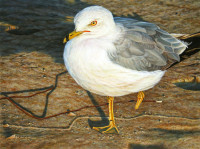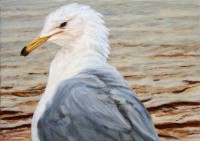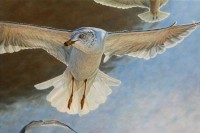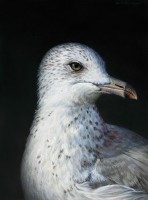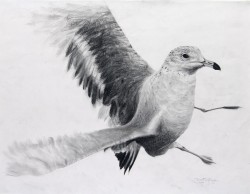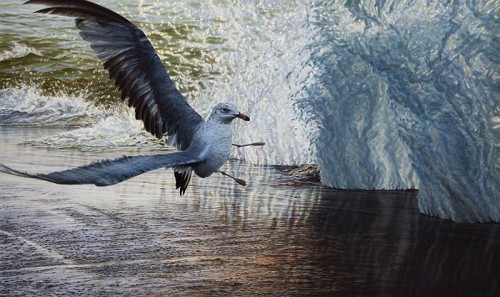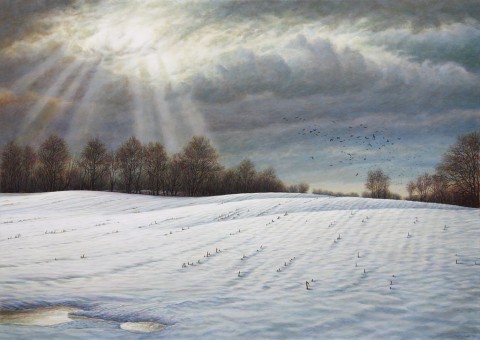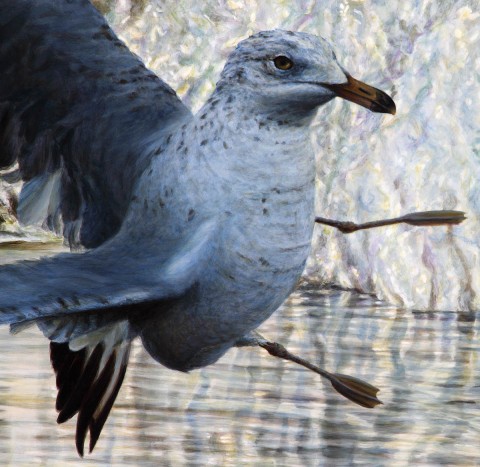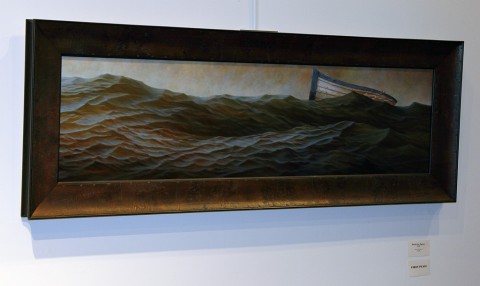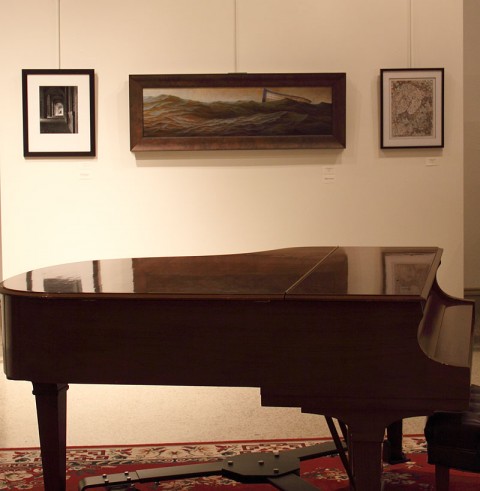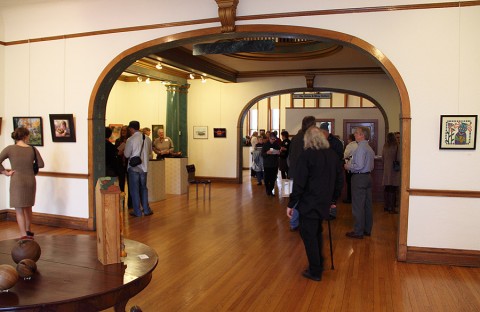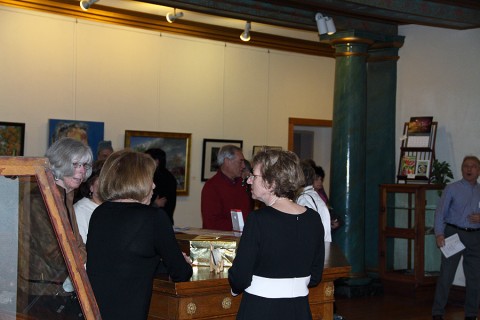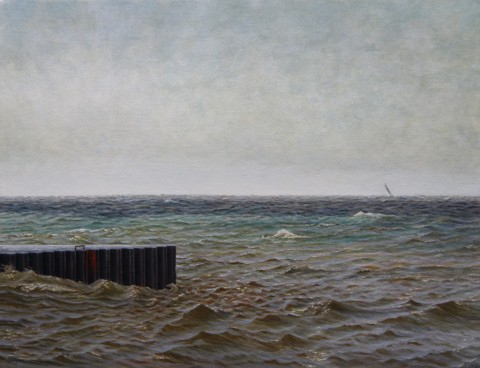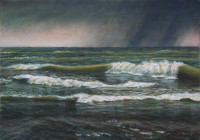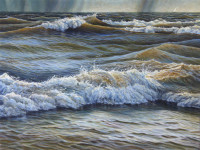Artistic Motivations: Acrylics Drawings Painting Seagulls Water
by David Jay Spyker
leave a comment
Gulls
Much like I’ve used boats and houses as metaphor for humanity, I’ve come to include seagulls as well. If you watch a large flock, you start to see how their society is arranged with its own hierarchies. You’ll notice the greedy squabbles, the games they play on a breezy summer day, and the clear – sometimes vicious – pecking order there is within the flock.
Amputee is a portrait of one particular gull I saw regularly at the north beach in South Haven. It had lost a foot to fishing line but in spite of the difficulty of landings and take-offs, it kept on going.
When I’d feed the flock there, this one was always at the front, and the others would give it a wide berth. It had a bit of a cantankerous spirit. People don’t always notice the missing foot right away, but when they read the title it clicks. There is a real expression of the tenacity of life here, and I’ve tried to capture that in the way the gull stares back with directness and defiance.
I’m a night owl, and to me the gull in this small piece (only 5 x 7 inches) looks like how I feel if I get up early in the morning, so I titled it “Self-Portrait in the Morning as a Gull”.
It’s amazing how quickly a hundred or more gulls will show up if you start tossing out bread or french fries. In “Compass” I wanted to record that experience. When you feed them, you’ll end up with two groups: one with the more timid gulls on the ground, the shyest standing farther away, and the second group flying in to catch thrown food mid-air.
The fliers have this regular routine where they form a sort of queue and work their way to within about a foot, then they hover there as long as possible. Occasionally the second gull in line will give the first an impatient peck in the back. They’ll look you right in the eye; it’s an intense, piercing sort of stare.
You can toss them food and the lead gull will catch it. If you hold up a fry, one will snatch it right from your fingers – their instinct to keep a safe distance gets put aside for their greed for food. Then it will veer off to eat mid-air while it circles around to the back of the line. They’ll just keep this up, cycling around and around, until you run out of food.
The title refers to the regular circling pattern, as well as the keen sense of direction that birds possess. I suppose it also speaks to the circular patterns of life.
To the right is another small one – 8 x 6 inches. I wanted to capture a particular quiet stare, and when it was finished I felt an odd personal connection, so it ended up getting the title “Baroque Self-Portrait as a Seagull”. The dark background and the lighting help reinforce the sense of a traditional baroque portrait.
In “Startled Gull”, I wanted to capture a sense of movement along the wings while retaining a stillness around the head and body, so I used quick finger smudges along the back edge of the lower wing.
“Sudden Flight” depicts the same seagull startled by waves of water jetting up along a soaked pier in South Haven, Michigan. There is something fleeting and fragile about life with the chaotic frenzy of the water crashing up behind the gull. It seemed so small and at the mercy of the greater power of nature – so transitory.
Click here to read a previous article about “Sudden Flight”.
Art Exhibitions: Acrylics Award Competition Crows Exhibition Painting Winter
by David Jay Spyker
leave a comment
“Winter Murder” Wins Award at Michigan Artists Competition
“Winter Murder” won the top Southwest Michigan Watercolor Society Award for water-based media at the Michigan Artist’s Competition in Battle Creek. The Watercolor Society sponsored three awards at this year’s show.
Also in the show is the piece, “Homeward”. See the exhibition at the Art Center of Battle Creek, 265 E. Emmett Street, Battle Creek, Michigan 49017 through June 29, 2013.
Art Artistic Motivations: Acrylics ArtPrize Birds Drawings Drybrush Painting Water Watercolors
by David Jay Spyker
leave a comment
Sudden Flight
I was in South Haven, Michigan, out on the north pier watching jets of water shoot up in the recesses along the steel side as the waves rolled in. This gull had been standing there on the soaked concrete, looking at me instead of the water behind, when it was startled into flight.
I felt this was a great image, and revisited it on and off for months. It started out as a thought about how life is fragile, and tied in with how I’ve been seeing gulls as metaphors for people. Here was this bird with all the world crashing around, and it seemed so small and at the mercy of the greater power of nature – so transitory.
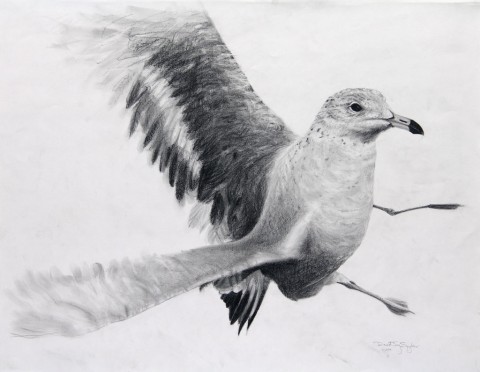
“Startled Gull” (Study for Sudden Flight), 2011
Graphite on Paper, 23 x 29 in., by David Jay Spyker~click to enlarge~
It took some time for the deeper personal connection to percolate up, and motivate me to actually get started on the painting:
When the phone rang the second time, I had a feeling something was wrong. Mom’s in the hospital; she had a massive stroke and might not live more than a day. That’s not something you want to hear.
I was on a plane bound for Florida early the next morning, a sudden flight filled with fears and barely restrained, intense sadness.
In spite of the reality of the situation – knowing that this wasn’t going to end with a miracle – hope would come and go throughout each day as I sat in the hospital room, traveled with family to a second hospital that had neurology specialists, and watched mom hooked up to tubes, machines, and monitors.
When you’re sitting there, and hope is not with you at the moment, a vacant numbness takes its place. These two things trade off, back and forth, and mix in with other powerful emotions to make a thick stew.
She never woke up. Her sudden flight had already happened about a week before she finally passed away.
Losing a parent changes something deep inside of you, way down in your core. The truth of your own mortality is never more clear. If you’re fortunate, you come away with the beginning of a more profound understanding of your own heart, and of the things that give meaning to your life.
The thing about life is we never know how much time we have. There is a glass-like fragility to life, to being out there in it all and experiencing the world through this gift we’ve been given.
Get out there and do something meaningful. Live with purpose. Try to be a better human being, be kinder, be more understanding, and especially be more open. That’s how I want to live.
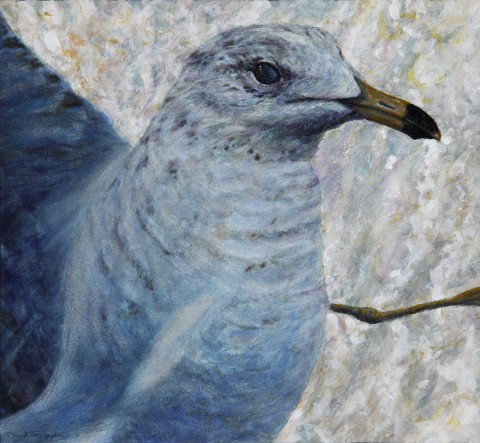
“Startled Gull” (Study for Sudden Flight), 2011
Watercolor and Acrylics on Paper (Lanaquarelle 140 lb. Cold Pressed)
10 5/8 x 11 1/2 in., by David Jay Spyker
~click to enlarge~
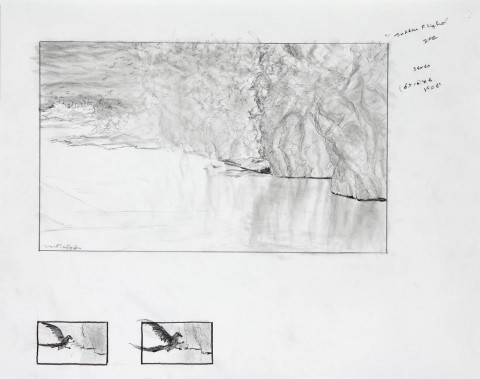
Study for Sudden Flight, 2012, Graphite on Paper (Stonehenge 100% Cotton)
11 x 14 in., by David Jay Spyker
~click to enlarge~
Sudden Flight is displayed in ArtPrize from September 18 – October 6, 2013 at St. Cecilia Music Center, 24 Ransom Ave. NE, Grand Rapids, MI 49503. If you’ll be visiting ArtPrize, please stop by St. Cecilia’s to see the painting.
ArtPrize 2013 Vote Code: 54406
Art Exhibitions: Acrylics Art Boats Competition Exhibition Painting Water
by David Jay Spyker
leave a comment
“Cradle” Awarded First Place at the Carnegie
At this year’s annual competition at the Carnegie Center for the Arts in Three Rivers, Michigan, the painting “Cradle” was awarded the first place prize. This installation of the exhibition was judged by artists Jim Markle and Dennis O’Mara.
Cradle was executed in 2011 using acrylics on canvas, and is painted with techniques that could be said to lie somewhere between those of oils and tempera with a bit more slant toward the latter.
Images of the opening reception:
Also showing at the annual exhibition are the paintings “Inlet” and “Northbound”.
The show is open through February 22nd, 2012 at the Carnegie Center for the Arts in Three Rivers, Michigan.
Art Exhibitions: Acrylics Art Competition Exhibition
by David Jay Spyker
leave a comment
Carnegie Center for the Arts Competition 2012
Three of my paintings – “Cradle”, “Northbound”, and “Inlet” – have been included in the CCA’s annual competition this year. The show opens with a reception on January 22 from 2-4 pm, and runs through February 22.
You can visit the Carnegie at 107 North Main St. in Three Rivers, MI 49093
Online at www.trcarnegie.com
Art Exhibitions: Acrylics Competition Exhibition Painting Rain Water
by David Jay Spyker
leave a comment
“Running” and “Rainstorm Off South Haven” at the Carnegie
Beginning Sunday, January 16, 2011, I will be showing “Running” and “Rain Storm Off South Haven” at the Carnegie Center for the Arts’ annual competition.
- “Rain Storm Off South Haven”, 2010, Acrylics on Canvas, 5 x 7 in., by David Jay Spyker
- “Running”, 2010, Acrylics on Canvas, 18 x 24, by David Jay Spyker
There is a reception from 2-4 p.m. with an awards ceremony at 3 o’clock on January 16 at the Carnegie Center for the Arts. The show closes on Saturday, February 19. I took a look at all the entries when I dropped off my pieces, and it should be a quality show; try to make the trip if you can.
Art: Acrylic Wash Acrylics Painting Techniques Watercolor Paper Waterfall
by David Jay Spyker
leave a comment
A Waterfall Study, Acrylics On Paper
I have been using Golden Paints’ Open Acrylics line of paints now for a while, and because of the extended working, or “open” time of the product, I thought I would try them on paper in a watercolor style. The finished piece is a nice little interpretation of Niagara Falls.
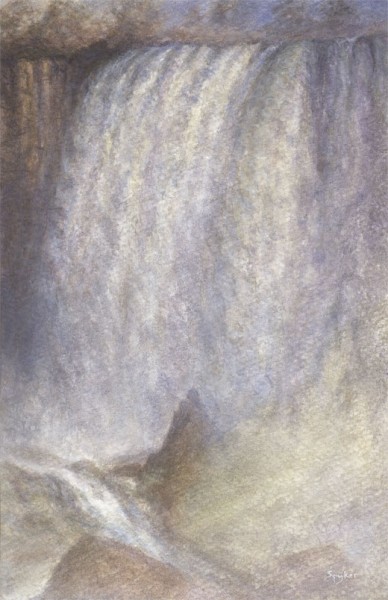
"Niagara", 2009, by David Jay Spyker - 5.5 x 8.5 inches - Acrylic Wash, Minor Drybrushing, and Paint on 100% Cotton Cold Press Watercolor Paper
The bulk of the painting was done on slightly damp to wet paper, but included some minor drybrushing, and some basic acrylic paint layering (particularly with whites and cobalt-tinted whites to achieve a misty look, and to bring back some highlights).
To thin the paints I used a mixture of distilled water, and Golden’s Open Liquid Acrylic Medium. The watercolor paper absorbed the paints very well, but I could tell toward the end that the pores in the paper were starting to get full of acrylics. Also, once fully dry, the paints will not become resoluble, so there is no going back in to blend colors later.
While not traditional watercolors, I think the acrylics performed very well in this application, and I may work on more acrylic washes on paper.
Art Exhibitions: Acrylics Art Competition Exhibition Painting Storm Water
by David Jay Spyker
leave a comment
28th Michigan Artists Competiton at the Art Center of Battle Creek
My recent painting, “The Journey” will be displayed at this year’s Michigan Artists Competition at the Art Center of Battle Creek.
Should you wish to attend, the group exhibition opens with a reception on October 4 from 2-4 p.m., and remains open to the public through October 24.
For directions and contact information, please visit the Art Center’s website here: www.artcenterofbattlecreek.org
The Acrylic Painters’ Forum
A forum for and about representational painters working in acrylics.
When I first began painting with acrylics, there were no local teachers instructing students about the finer points and advanced techniques of the medium. The medium is young when compared to oils, and has undergone significant changes and improvements in just the last decade. Even now, the number of advanced acrylic painting instructors is small, and the medium’s potential is still being explored and developed by both the artists and the acrylics manufacturers.
I learned to work with acrylics by experimentation, and by reading every book I could find on the subject. In the beginning, I tried many different brands of paint, until I finally discovered artists’ acrylics made by Golden Paints. More than a decade ago, Golden was there with detailed technical advice in the form of product data sheets, color indices, and such. There were times I spoke with the head of their laboratory over the phone; Mark Golden even answered the phone once, and I spoke with him for a while.
Teaching oneself to paint, while rewarding, can be an arduous journey. I would like the discussions in this forum to provide the same level of support and assistance to acrylic painters that Golden has always supplied to artists – to make the journey a little less arduous. I hope this forum will provide a place where representational painters working in acrylics can share techniques and ideas, and develop a sense of community. Together, we can lift each others’ art to greater levels of mastery.
I invite representational painters working in acrylics, and anyone interested in the style and medium, the art, and the artists to join the forum at http://www.acrylicsforum.davidjayspyker.com/.
The acrylics forum has since been closed: http://www.acrossthewaters.davidjayspyker.com/2007/11/23/the-acrylics-forum-is-closed/
